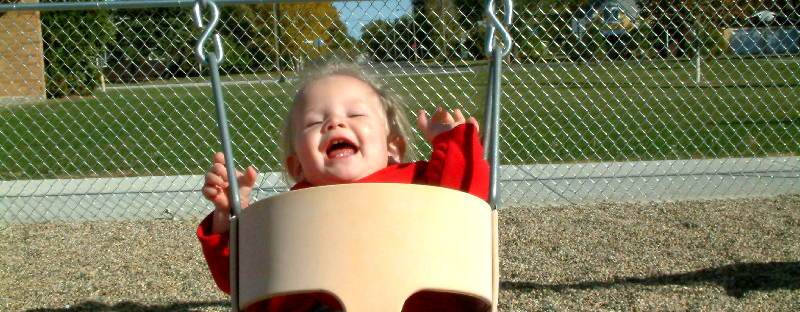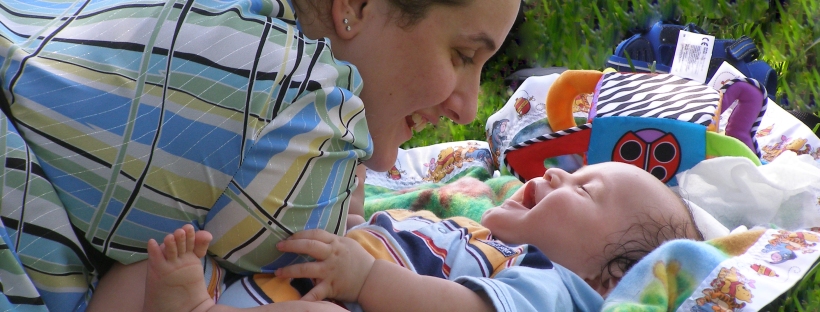Try this to make your baby more comfortable and less scared of this position. Carry and burp your baby up close to your shoulder so that his head is above your shoulder and facing the opposite way you are. This is an easy way for your baby to get used to pressure on his belly side while being in a comforting position. It also engages his neck muscles. Make sure to support his head if he still does not have control of it. As he gets stronger, you can move him higher and higher above your shoulder. Aim to hold him in this position at least 15min. This will count as 1 round of your 4 daily sessions of tummy time. Feel free to repeat this exercise.
Category: 0-3A
Chest to Chest
Lay on your back and put his tummy on your chest or your tummy, so you will be chest to chest. Try to encourage him to lift his head by talking to him and giving encouraging words. If he is very young and this is his first exposure to tummy time, you can pick him up a few minutes (or even seconds) into fussing. Then increase your goal to 5min next time, then 7min, 10min, 12min, and 15min. Your goal is to get to at least 20min of tummy time 4 times a day or 25min of tummy time 3 times a day.
Tummy Time
Place baby gently on her tummy. Make sure the surface is not too soft or hard. A blanket or play mat covering the ground is a good tummy time spot. Of course, always be next to her. Talk to her and give encouraging, comforting words. She most likely will not like tummy time at first and will fuss. That’s OK! Try for at least 5 min in the beginning, and if she isn’t having it, go ahead and end early. Slowly increase her tummy time. If she is still fussy, increase time before picking her up by 2 min every other day. If she is not fussy, let her play until she gets bored. A pro at Tummy Time? Keep engaging her through face to face interaction, words, and toys to help her practice raising her head, chest, and eventually lift with her arms. Goal of tummy time is at least 25min three times a day.
Early and Often Baby Activities
Parentese, which is how most people naturally want to speak to babies and toddlers, is higher pitched overall with wide swings in pitch when spoken. This gives parentese its singsong quality. Along with its high intonation(variations in pitch) characteristics, parentese allows for babies to pick up different speech patterns as well as distinct words, vowels, and syllables.
Parents all over the world speak in parentese, regardless of the language spoken. Let your natural instinct and voice come out as you talk with your child. Remember, communicating early and often is the best recipe for language development!
Parentese
The sing-song voice we naturally want to speak with babies and small children is called parentese. And, wouldn’t you know, this natural instinct has been shown to be preferred by babies. It is a great vehicle for children to pick up speech and speech patterns.
If you have been talking parentese to your little one already- great! Keep it up, and aim to pick 3 times today when you find you are not talking to your little one. Stop what you’re doing and converse with her. If you haven’t been using parentese or feel foolish for doing so, now is the time to start. This is the best way for babies to pick up language. Spread the word about the impact parentese has on a child’s language development. Aim to speak to your baby in parentese today.
Richness in Sound Baby Activity
Give her a rich experience of sound! Take her for a walk outside where many of her senses will be engaged! She can feel the breeze and warmth of the sun on her skin, she can hear the world of sounds outside, and she can feel her body in motion. Aim to walk at least 15-30min.
Balance and Motion Infant Activity
Our vestibular system is a sensory system to help us with balance, position, and motion. When this sense is stimulated in babies (usually by some form of movement), it not only helps their sensory abilities develop, but also helps their motor abilities and early brain development overall. As you have probably already discovered when you trigger it, the added benefit is that it is comforting to your baby! Here are ways to stimulate the vestibular system:
- Sit in a comfortable seat and lay your baby on your lap. Sway and rock your baby rhythmically and gently from side to side. Talk or sing to her.
- Rock, jiggle, swing, bounce, and carry your baby around. Even putting her in a sitting position (make sure she is developmentally ready) or propped up on pillows is a different position compared to what she’s usually in and will stimulate her vestibular system.
As always, practice safety. Do not do rigorous movements. Make sure your baby’s head is stabilized either by you or by themselves if they are strong enough.
Language & Turn Taking Baby Activity
Have a conversation with your baby, face-to-face! Let him learn the patterns of conversation through turn taking. You say something, maybe ending with a question, and then pause to let him have a chance to “say” something. All that babbling is him talking to you! Even if he isn’t babbling back yet, still pause before talking again. Engage in conversation as long as he is interested- aim for 10-15minutes. Soon, you’ll be amazed how quickly he understands turn taking! He will just love spending quality, focused time with you just talking!







